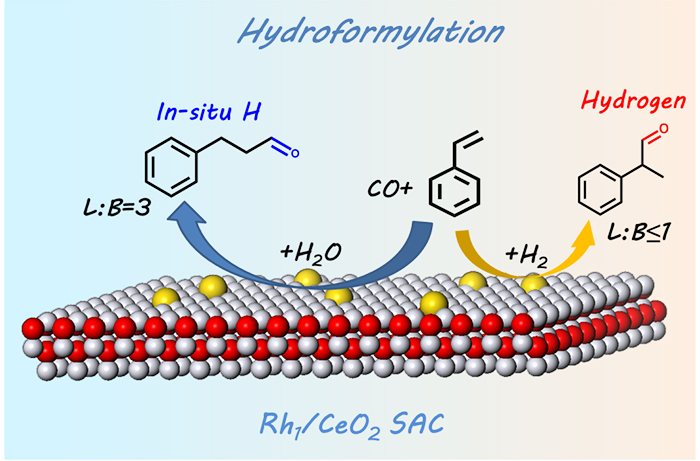Recently, research group led by Prof. ZHANG Tao and Prof. QIAO Botao from the Dalian Institute of Chemical Physics (DICP) of the Chinese Academy of Sciences found a novel approach to selectively obtain linear aldehydes in hydroformylation of styrene and its derivatives by coupling with a water-gas shift reaction on Rh single-atom catalyst supported by CeO2 without using any ligands. The results were publised in Angew. Chem. Int. Ed.
Hydroformylation of olefins is one of the most important homogeneously catalyzed industrial reactions for aldehyde synthesis. Various ligands are usually used to obtain desired linear aldehydes in aliphatic olefin hydroformylation.
However, in aromatic hydroformylation it prefers to obtain branched aldehydes with common ligands, posing a grand challenge for the synthesis of linear products. To obtain high selectivity to linear aldehyde, steric hindrance ligands, such as triphosphoramidite and tetradentate phosphine, have to be used, which are generally followed by the problem of high cost and complex synthetic procedure.
Therefore, the development of new approaches to manipulate the regioselectivity of styrene hydroformylation remains attractive but challenging in both fundamental study and practical applications.
Detailed studies in this work revealed that the in situ H generated from the water-gas shift plays a critical role in determining the high regioselectivity to linear products. Besides, comparied with Rh single-atom catalyst, Rh homogeneous catalysts are much less active because of the inability to catalyse water-gas shift reaction, and Rh nanoparticle catalysts are mainly corresponding phenylpropanols rather than aldehydes, result in the decrease of chemoselectivity.

The coupling of a traditionally homogeneous catalysis process with a heterogeneous catalysis reaction to tune product selectivity may provide a new avenue for the heterogenization of homogenous catalysis process.
This work was supported by National Natural Science Foundation of China, National Key Projects for Fundamental Research and Development of China, Strategic Priority Research Program of the Chinese Academy of Sciences, DNL Cooperation Fund, CAS and LiaoNing Revitalization Talents Program. (Text and Imaged by LI Tianbo)